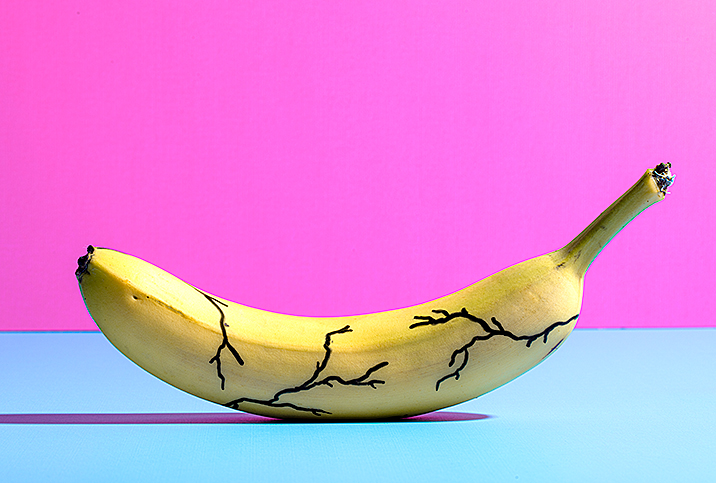The Science of Girth: What is Considered Average?

Buried deep in the most obscure, phallocentric online forums are posts by curious guys regularly asking the same question: Do I have a pencil dick? There's even an entire—very NSFW, obviously—subreddit dedicated to slimline penises, where 1,700 members post and analyze photos of their junk to see how they stack up against others.
It's no secret we live in a world obsessed with dick length—see the extensive lists of usually size-related nicknames like "anaconda" and "fuckpole" as proof—but what about dick girth?
When it comes to circumference, there are only two commonly used descriptors: the aforementioned long, thin "pencil dick" and the short, chubby "chode," defined as a "dick wider than it is long." This comparative lack of verbal variety suggests dicks come in all shapes, sizes and lengths, but only two options for girth—and judging by the mere existence of forums dedicated to diagnosing "pencil dicks," this lack of specificity seems to be causing a whole lot of anxiety.
There's research behind average girth to consider
Researchers have spent decades combing the world for statistics on average dick size, but arguably the most thorough study so far came from the British Journal of Urology International in 2014. Researchers developed strict criteria to select and then dissect existing figures, excluding data that was self-reported—and therefore more likely to be generous—or made up of the estimated 2.28 percent men worldwide with "abnormally small" penises.
This comparative lack of verbal variety suggests dicks come in all shapes, sizes and lengths, but only two options for girth.
The results were surprising, and a far cry from the myth of 6 inches being the international norm. When it came to size, the average flaccid length was 9.16cm (3.6 inches), a figure that rose to 13.12cm (5.17 inches) when erect. As for girth, the average flaccid circumference was actually 9.31cm (3.66 inches)— basically, research proves the majority of soft dicks are, in fact, "chodes." The average erect circumference was 11.66cm (4.6 inches), indicating erections have a greater impact on length than girth.
More research is emerging. For example, a 2019 study on cosmetic penile enhancement published in Scientific Reports featured a comparative list of previous research findings, and girth varied notably from country to country—flaccid penis girth ranged from 8cm (3.14 inches) in a 2014 study conducted in China to 11.50 cm (4.52 inches) in 2015 research carried out in Saudi Arabia.
It goes without saying, but there is no such thing as a "normal" penis, and even within these figures, there will undoubtedly be countless anomalies.
Why are we so concerned about average dick girth and size, anyway?
According to U.K.-based psychosexual therapist Silva Neves, the origins of our fascination with "penis size and girth is hard to know, but there are plenty of ancient artworks and paintings depicting larger-than-average penises all over the world, so it's nothing new." His theory is that big dicks are seen as a symbol of "high male fertility" and "masculine power," a narrative still propped up by mainstream porn. "In reality, large, girthy penises are not practical for sex," he continued. "Most people prefer to have sex with someone with an average-sized penis."
Part of the problem lies in the way we talk about sex and our bodies, which is still often cloaked in shame and reluctance. Sharing the aforementioned research on Reddit attracted responses from several anonymous users, who spoke openly about their own penis anxieties and the way they compare themselves to so-called "average" statistics, which are frequently inflated in casual conversations. A handful echoed the claim that porn peddles unrealistic standards, whereas others explained only getting a bird's-eye-view of their own junk—the so-called "perception-shortening angle"—compared to the frontal view we occasionally get of other penises in public settings, like gym changing rooms and showers.
Only 55 percent of penis owners are genuinely happy with the length and girth of their junk, indicating penis anxiety of varying descriptions is widespread.
Anyone worried they might fall into the categories of "pencil dick" or "chode" might also have a distorted perception of their bodies, otherwise known as BDD (body dysmorphic disorder).
Statistical research on BDD specifically is still lacking—the most-cited study, which was published in Dialogues in Clinical Neuroscience and found 2.2 percent of men suffer with BDD, dates way back to 2010. Further evidence, cited by the U.K.'s National Health Service (NHS), reveals only 55 percent of penis owners are genuinely happy with the length and girth of their junk, indicating penis anxiety of varying descriptions is widespread. This can have knock-on consequences for sex and relationships. "If people think their penis isn't good enough, it creates shame because society teaches us to correlate someone's penis with their masculinity," Neves said. "That underlying shame can stop people dating and connecting with sexual partners, and can even lead to unreliable erections or avoidance of sexual situations."
The key takeaway is that when it comes to length and girth, there really is no such thing as "normal"— sure, studies give us a glimpse, but even existing research shows discrepancies of whole inches based on geography alone. It's clear the spectrum of girth runs way wider than just "chode" and "pencil dick," but the porn industry and conservative societies more widely—which often spend time lobbying against inclusive sex-ed—seemingly aren't ready for these conversations.
Whether thick or thin, the enormous diversity of dicks worldwide is impossible to truly quantify—just know that whenever you hear friends brag about the size of their dick, they're likely trying to measure up to so-called "average" stats, which are vastly overstated.


















